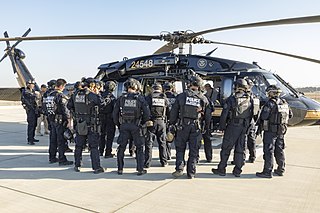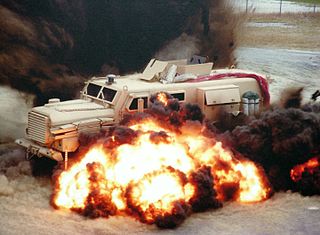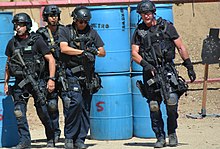
The High Mobility Multipurpose Wheeled Vehicle is a family of light, four-wheel drive, military trucks and utility vehicles produced by AM General. It has largely supplanted the roles previously performed by the original jeep, and others such as the Vietnam War-era M151 Jeep, the M561 "Gama Goat", their M718A1 and M792 ambulance versions, the Commercial Utility Cargo Vehicle, and other light trucks. Primarily used by the United States military, it is also used by numerous other countries and organizations and even in civilian adaptations. The Humvee saw widespread use in the Gulf War of 1991, where it navigated the desert terrain; this usage helped to inspire civilian Hummer versions. The vehicle's original unarmored design was later seen to be inadequate, and was found to be particularly vulnerable to improvised explosive devices in the Iraq War. The U.S. hastily up-armored select models and replaced front-line units with the MRAP. Under the Joint Light Tactical Vehicle (JLTV) program, in 2015 the U.S. Army selected the Oshkosh L-ATV to replace the vehicle in front-line U.S. military service.

The Albanian Armed Forces are the military of Albania and were formed after the declaration of independence in 1912. Today, it consists of the General Staff, the Albanian Land Force, Albanian Air Force and the Albanian Naval Force.

Thetford Township, is a civil township of Genesee County in the U.S. state of Michigan. The population was 6,640 at the 2020 census, a significant decrease from 7,049 at the 2010 census.

In the United States, a SWAT team is a generic term for a police tactical unit.
In the United States, a special agent is an official title used to refer to certain investigators or detectives of federal, military, tribal, or state agencies who primarily serve in criminal investigatory positions. Additionally, some special agents operate in criminal intelligence, counterterrorism, or counterintelligence-based roles as well, with one or all of these roles occasionally taking precedence over criminal investigatory tasks.

The Defense Logistics Agency (DLA) is a combat support agency in the United States Department of Defense (DoD). The agency is staffed by over 26,000 civilian and military personnel throughout the world. Located in 48 states and 28 countries, DLA provides supplies to the military services and supports their acquisition of weapons, fuel, repair parts, and other materials. The agency also disposes of excess or unusable equipment through various programs.

The Police is the Polish national civilian police force. It is a primary law enforcement agency in the country, tasked with providing public safety and order, investigating and preventing crime.
A United States defense standard, often called a military standard, "MIL-STD", "MIL-SPEC", or (informally) "MilSpecs", is used to help achieve standardization objectives by the U.S. Department of Defense.

As of 2020, more than 800,000 sworn law enforcement officers have been serving in the United States. About 137,000 of those officers work for federal law enforcement agencies.

The Albanian State Police is the national police and law enforcement agency which operates throughout the Republic of Albania. The collapse of the Communist system and the establishment of political pluralism post-1991 brought important changes to the structure of the Albanian Police. The Ministry of Public Order and the General Directorate of Police were established in April 1991, and the new law of July 1991 established the Public Order Police. Nearly 80% of police manpower, i.e. personnel who had served under the previous system, were replaced by new recruits. On 4 November 1991, the Albanian Police was accepted as a member of Interpol. The emergency number is 129.
DLA Disposition Services is part of the United States Defense Logistics Agency. Headquartered at the Hart–Dole–Inouye Federal Center in Battle Creek, Michigan, the organization provides personnel to support the US military in 16 overseas deployments, including Iraq and Afghanistan, 2 US territories and 41 states.

The Cadillac Gage Ranger, known popularly and in United States military service as the Cadillac Gage Peacekeeper or Cadillac Gage Peacekeeper I, is a four-wheeled armored personnel carrier marketed as an internal security vehicle, produced by Cadillac Gage. Built on a Dodge truck chassis, production began in 1979 to produce an armored vehicle for the United States Air Force (USAF) Security Forces, its largest customer, though Luxembourg and Indonesia also reportedly used Rangers as well. The Ranger also saw considerable service with law enforcement as a SWAT vehicle.

Mine-Resistant Ambush Protected is a term for United States military light tactical vehicles produced as part of the MRAP program that are designed specifically to withstand improvised explosive device (IED) attacks and ambushes. The United States Department of Defense MRAP program began in 2007 as a response to the increased threat of IEDs during the Iraq War. From 2007 until 2012, the MRAP program deployed more than 12,000 vehicles in the Iraq War and War in Afghanistan.

United States Department of Defense Police are the uniformed civilian security police officers of the United States Department of Defense (DoD), various branches of the United States Armed Forces, or DoD agencies.

The Caiman is an MRAP with a V-hull design based on the Family of Medium Tactical Vehicles (FMTV) and Low Signature Armored Cab (LSAC), initially developed by Stewart & Stevenson and now produced by BAE Systems Platforms & Services.

The United States Department of the Air Force Police is the uniformed security police program of the Department of the Air Force (DAF). It provides professional, civilian, federal police officers to serve and protect U.S. Air Force (USAF) and Space Force (USSF) personnel, properties, and installations. DAF Police personnel represent the DAF's contribution to the Department of Defense Police program. DAF Police officers primarily work alongside USAF Security Forces, the military police of the USAF and USSF. Although a separate branch from the USAF, the USSF still falls-under the DAF, therefore law enforcement services are provided to the USSF by the DAF Police and USAF Security Forces. Although the Air Force Office of Special Investigations employs civilian special agents, it does not fall-under either the DAF Police or DoD Police umbrella.

The Lenco BearCat is a wheeled SWAT vehicle designed for military and law enforcement use. It is in use by several military forces and law enforcement agencies around the world.

The militarization of police is the use of military equipment and tactics by law enforcement officers. This includes the use of armored personnel carriers (APCs), assault rifles, submachine guns, flashbang grenades, sniper rifles, and SWAT teams. The militarization of law enforcement is also associated with intelligence agency–style information gathering aimed at the public and political activists and with a more aggressive style of law enforcement. Criminal justice professor Peter Kraska has defined militarization of police as "the process whereby civilian police increasingly draw from, and pattern themselves around, the tenets of militarism and the military model".

The United States Marine Corps Civilian Police is the civilian law enforcement agency of the United States Marine Corps. Officially called the "Marine Corps Law Enforcement Program" (MCLEP), the agency is composed of civilian (non-military) federal police officers.
School disturbance laws, also known as school disruption laws, are a series of state laws within the United States that prohibit and instill penalties for those found guilty of disturbing the operations of a school. In some states, merely "disturbing school" is a crime, with the law giving no further definition or guidance to those charged with enforcing the law. Enacted by states in the early 20th century to protect students from outside adults, since the Civil Rights Era they began to be used against students within the schools. As of 2017, there are over 20 states with these laws still in place, although they remain actively enforced by only some. It is reported that nationally, 10,000 juveniles are charged with "disturbing school" each year, in addition to those who are charged as adults. The application of these laws, including arrest, expulsion, and incarceration, are in many states part of the "school to prison pipeline," the channeling of students of all ages into the criminal justice program. This frequently has adverse effects on students' academic performance, ability to remain in the educational system, likelihood of adult incarceration, and their future success in society.



















